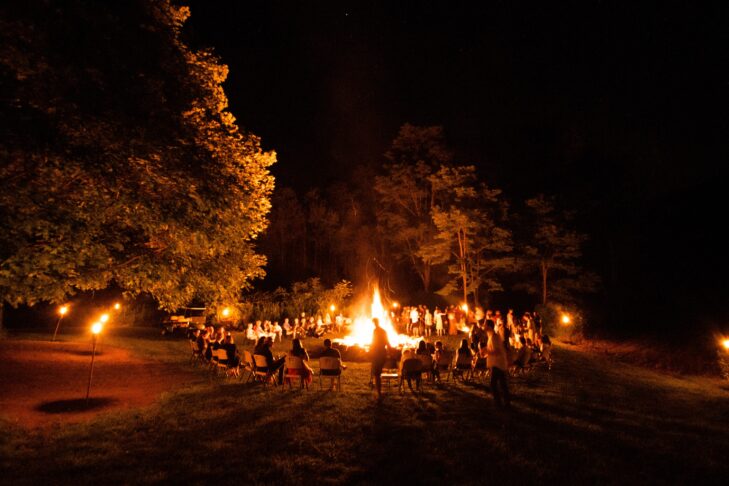Lag B’Omer is a minor Jewish holiday that falls on the 33rd day of the omer and is celebrated on the 18th day in the month of Iyar. This year, the holiday will fall on Saturday evening, May 25, and continue into Sunday, May 26. Lag B’Omer is a portmanteau of the traditional Hebrew notation of the letters lamed and gimel that add up to the number 33. And the period of counting the days between Passover and Shavuot is known as the omer—the word for an agricultural measure of grain.
Lag B’Omer’s origins are vague. However, the omer is described in Leviticus 23:15-16 as the 49 days between Passover and Shavuot that must be counted: “You shall count from the eve of the second day of Passover, when an omer of grain is to be brought as an offering for seven complete weeks. The day after the seventh week of you counting will make 50 days, and you shall present a new meal offering to God.”
In the absence of a centralized Temple, counting the seven weeks of the omer takes the place of offering a ritual meal or sacrifice. The omer also links Passover, the holiday of freedom, to Shavuot, the giving of the Torah. An interpretation of these weeks of the omer proffers that Passover’s freedom is not complete until Jews commemorate the giving of the Torah on Shavuot at Mount Sinai.
The holiday Lag B’Omer is first mentioned in the Middle Ages. Aside from Lag B’Omer, which is a singular day of joy, the other days of the omer are designated as a period of semi-mourning. During this time, festivities such as weddings are not conducted. And as with any official period of Jewish mourning, haircuts and shaving are also forbidden. However, there is no cessation of daily activities, such as attending school or going to work.
Lag B’Omer customs
A frequently cited explanation of Lag B’Omer’s origin describes a plague that killed 24,000 of Rabbi Akiva’s students that ended on the 33rd day of the omer. The Talmud explains the students perished because they did not treat each other respectfully. The omer resumes as a period of mourning, presumably to mark the severity of the students’ punishment.
The holiday is also associated with Rabbi Shimon bar Yochai, known by the acronym Rashbi, who lived in the second century of the Common Era. Rashbi, the author of the Zohar, was the first teacher and scholar to give the holiday a kabbalistic patina. Accordingly, the days and weeks between Passover and Shavuot represent various combinations of sefirot, or divine emanations, such as kindness, power and splendor. The emanations are thought to help spiritually cleanse the mind and soul in preparation for receiving the Torah. As a side note, some rabbis in the Talmud connected Lag B’Omer’s inherent joy with manna’s first appearance in the desert on the 18th of Iyar.
Other sources explain that Rashbi declared the 33rd day of the omer as one of joy. It is also Rashbi’s yartzheit, and on the day he died, he instructed his disciples to celebrate rather than mourn his death. Rashbi’s grave on Mount Meron is a frequent destination for pilgrims and the mountain still hosts Lag B’Omer festivities.
Lag B’Omer and Israel
Writing in Haaretz, Israel’s English language daily newspaper, Rabbi Benny Lau offers a cogent explanation of Lag B’Omer’s significance in contemporary Israel. Lau writes: “…Lag Ba’omer became a part of the Israeli-Zionist psyche during the first years of Zionism and Israel. A clear distinction became evident between Jews and Israelis in the way the day was celebrated: The religious Jews lit torches in Rashbi’s honor and sang songs about him, while young Israelis, sitting around an alternative bonfire, sang about a hero ‘whom the entire nation loved’ and focused on the image of a powerful hero who galloped on a lion in his charges against the Romans.”
The “powerful hero” who charged the Romans “galloping” on a lion was the warrior Bar Kochba. Seeing Lag B’Omer through the lens of Bar Kochba’s initial victory over the Romans in 132 CE sidelined Rabbi Akiva and Rashbi in contemporary versions of the holiday’s narrative. Bar Kochba’s army lit bonfires to symbolize its military success, thus elevating bonfires as an emblem of modern Lag B’Omer celebrations.
By the late 1940s, a Zionist reading of the holiday inspired Israeli school children to view Bar Kochba as the hero of Lag B’Omer. This version of the holiday’s history encouraged dancing and singing around nighttime bonfires and playing with bows and arrows during the day as a reminder of how Bar Kochba’s forces initially triumphed over the Romans. Other sources attribute an earlier presence of bonfires to the light and wisdom that Rashbi spread throughout ancient Israel.
Today, Lag B’Omer celebrations reflect Israel’s cultural and religiously observant diversity. Honoring Rashbi’s wishes, kabbalist-inspired pilgrimages to Meron include ultra-Orthodox parents traditionally cutting their 3-year-old sons’ hair for the first time. Secular Israelis celebrate the day throughout the country by roasting potatoes, marshmallows, hot dogs and other foods in bonfires.
The holiday is also a celebration of the Zionist fighting spirit. The Palmach division of the Haganah was founded on Lag B’Omer in 1941. To that end, the Israel Defense Forces was created on the holiday in 1948. In 2004, the Israeli government designated Lag B’Omer as a day to honor IDF reservists.



